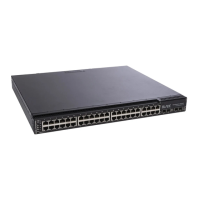16 RackSwitch G8000: Application Guide
Part 3: Switch Basics
•
Chapter 8, “VLANs,” describes how to configure Virtual Local Area Networks
(VLANs) for creating separate network segments, including how to use VLAN
tagging for devices that use multiple VLANs. This chapter also describes
Protocol-based VLANs, and Private VLANs.
•
Chapter 9, “Ports and Trunking,” describes how to group multiple physical ports
together to aggregate the bandwidth between large-scale network devices.
•
Chapter 10, “Spanning Tree Protocols,” discusses how Spanning Tree Protocol
(STP) configures the network so that the switch selects the most efficient path
when multiple paths exist. Covers Rapid Spanning Tree Protocol (RSTP),
Per-VLAN Rapid Spanning Tree (PVRST), and Multiple Spanning Tree Protocol
(MSTP).
•
Chapter 11, “Quality of Service,” discusses Quality of Service (QoS) features,
including IP filtering using Access Control Lists (ACLs), Differentiated Services,
and IEEE 802.1p priority values.
Part 4: Advanced Switching Features
•
Chapter 12, “Virtualization,” provides an overview of allocating resources based
on the logical needs of the data center, rather than on the strict, physical nature
of components.
•
Chapter 13, “Stacking,” describes how to combine multiple switches into a single,
aggregate switch entity.
•
Chapter 14, “VMready,” discusses virtual machine (VM) support on the G8000.
Part 5: IP Routing
•
Chapter 15, “Basic IP Routing,” describes how to configure the G8000 for IP
routing using IP subnets, BOOTP, and DHCP Relay.
•
Chapter 16, “Internet Protocol Version 6,” describes how to configure the G8000
for IPv6 host management.
•
Chapter 17, “IPsec with IPv6,” describes how to configure Internet Protocol
Security (IPsec) for securing IP communications by authenticating and
encrypting IP packets, with emphasis on Internet Key Exchange version 2, and
authentication/confidentiality for OSPFv3.
•
Chapter 18, “Routing Information Protocol,” describes how the N/OS software
implements standard Routing Information Protocol (RIP) for exchanging TCP/IP
route information with other routers.
•
Chapter 19, “Internet Group Management Protocol,” describes how the N/OS
software implements IGMP Snooping or IGMP Relay to conserve bandwidth in a
multicast-switching environment.
•
Chapter 20, “Multicast Listener Discovery,” describes how Multicast Listener
Discovery (MLD) is used with IPv6 to support host users requests for multicast
data for a multicast group.
•
Chapter 21, “Border Gateway Protocol,” describes Border Gateway Protocol
(BGP) concepts and features supported in N/OS.
•
Chapter 22, “OSPF,” describes key Open Shortest Path First (OSPF) concepts
and their implemented in N/OS, and provides examples of how to configure your
switch for OSPF support.

